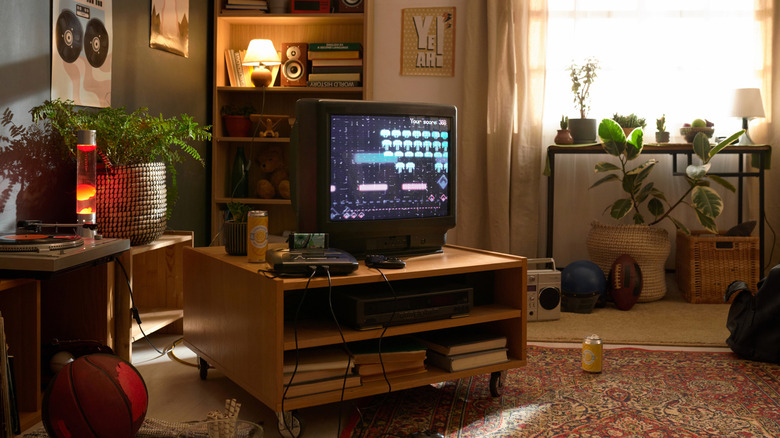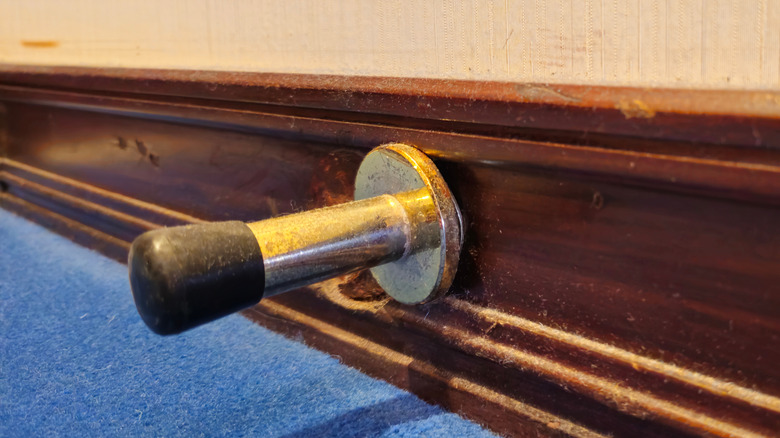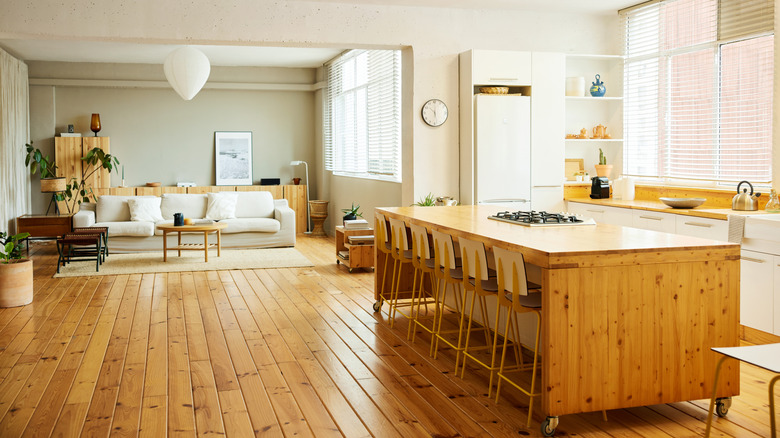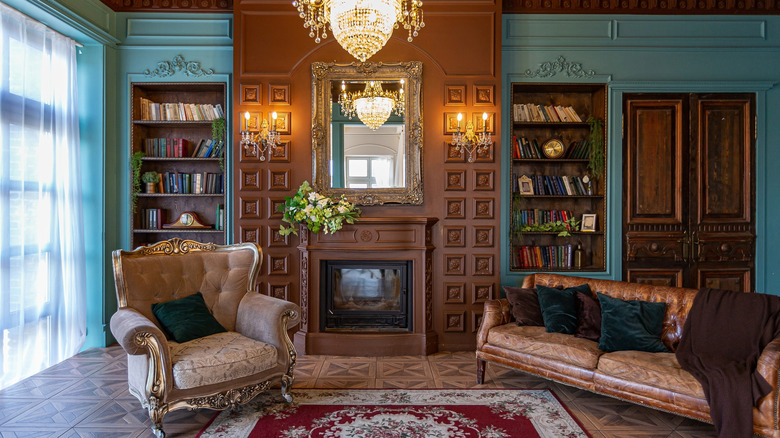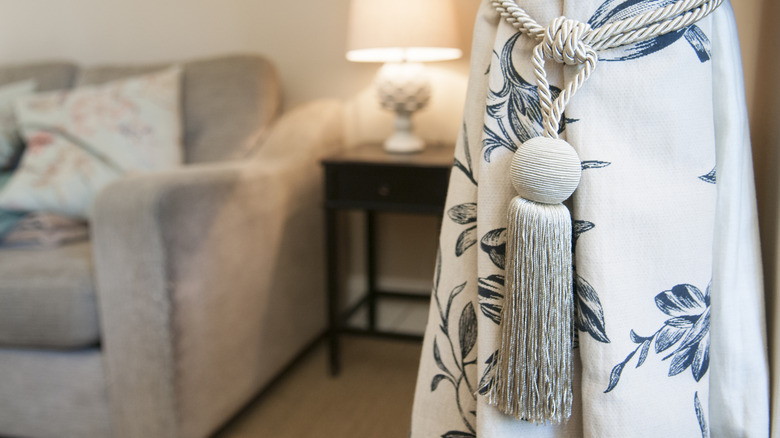1990s Decor Trends Our Design Expert Doesn't Want To Come Back
Trends from the 1990s have been brought back to the zeitgeist so frequently that Taylor Swift wrote the lyric: "I come back stronger than a '90s trend." The last decade of the 20th century lives on throughout fashion, decor, music, and other aspects of modern culture; and, for the most part, that's a good thing. However, there are some trends from that era that simply shouldn't be revived. Decor expert Sarah Bilotta, who has a master's in the history of design from Oxford University, spoke exclusively with House Digest about the '90s decor trends that she hopes will stay in the last millennium.
But first, we want to clarify that not all of your favorite trends made it onto our expert's no-no list. You can bring back the 90s in your home decor with trends that are pretty timeless and add fun pops of color and personality to your home. "Don't be afraid to go nostalgic with your home decor," Bilotta told us. "You can take some tasteful inspiration from the 1990s without going overboard." There are plenty of design elements that have rightfully resurfaced from the past, like the sense of maximalism that defined the decade. Keep reading for the dos — and don'ts — from an expert's perspective.
Avoid dark wooden trim
One trend that Bilotta doesn't love is the dark wood that was just about everywhere in the 90s. "I'm not a fan of the dark wood trims that became popular around this time," she told House Digest exclusively. "Doors, door cases, and baseboards were overwhelmingly made from naturally deep woods or wood stained a rich tone." Unfortunately, many homeowners are still opting for this aesthetic; wooden baseboards are still pretty popular, even the dark stained versions.
Bilotta's preference on the matter has more to do with the decor around the wood than simply the wood itself. "I think this is a huge design mistake unless you really know how to work with these deep wood hues," she told us. "They are very hard to complement with wall colors and decor, and they can end up making your space look dark and dreary if you don't balance them with bright neutrals. This is hard to do, even for experienced designers, so newbies especially should avoid dark wood trims." That being said, if you are someone who's clutching your dark wood accents with both hands, you can focus on brightening up the rest of your space to avoid this overly dark look.
Not every floor needs hardwood
Bilotta told House Digest that the proliferation of hardwood floors happened mostly at the end of the last millennium. "I think in the 1980s and '90s people were rebelling against the linoleum craze of the mid-20th century by filling their homes with natural materials," she said. And, while hardwood floors can be magical in some spaces, they don't necessarily need to exist in every single room within your home. "In high traffic areas like hallways and kitchens, the sealant can quickly wear down, exposing the wood and leaving it prone to scratches and stains from moisture," Bilotta warned.
To avoid the unappealing wear and tear that hardwood invites into your most-used spaces, you can easily swap it out with some vinyl planks that give the same aesthetic appeal without the high potential for visible damage. "There are so many high quality vinyl flooring options available now, I prefer these options in kitchens and high traffic areas," Bilotta said. "No one will know the difference, but it will mean a lot less upkeep for you!" You can get vinyl flooring at just about any hardware store, or order products like the Tivoli II self-adhesive vinyl planks (on Amazon for $27.62).
Reproduced antique furniture is a no
Vintage furniture is typically a great option — it's good for the environment and typically timeless and high quality. Fake antiques are high on the list of things to avoid, though. "The '90s were known for reproduction antique furniture, from huge pedimented armoires à la Louis XV France to Shaker-style cabinets sold by Americana-themed design retailers," Bilotta told House Digest exclusively, adding, "I can't stand this trend!"
Instead, she recommends investing in the real thing. "You can go to your local thrift store or antique shop and pick up a real vintage piece for way less money," she said. "Plus, you're preventing that piece from ending up in a landfill and helping create less waste by reducing the demand for new furniture. There are lots of ways to make a worn piece of furniture new again, so even if the antique piece you want isn't in perfect condition, you can save money by DIYing and giving it a new life." Simple products like an electric fabric shaver ($9.99 on Amazon) and Leather Honey's leather conditioner ($19.99 on Amazon) will make your thrift store finds feel brand new all while avoiding the faux pas of buying fake vintage pieces.
Three trends you can invest in
Like we said up front, 1990s decor trends aren't a no across the board. One easy way to introduce nostalgia into your decor is to lean into color. "Designers of the '90s weren't afraid to go bold with color, but instead of going all-out, try a pop of neon in the form of a picture frame, vase, book ends, or their pillows," Bilotta recommended. You can, therefore, buy colorful neon items like a bright yellow acrylic vase ($17.28 on Amazon) or hot pink throw pillows ($23.99 on Amazon) for your home, but be sure to commit to color if you want a tied-together look.
Bilotta additionally warns House Digest readers to avoid the "clutter" that maximalism sometimes invites by instead "sticking to larger-scale accessories like dramatic oversized table lamps or floor-to-ceiling floral curtains, rather than using pieces that look too small for the space."
Finally, patterned textiles are a great way to go back to the '90s in your home. "Classic English floral and striped curtains by Bennison decorated the homes of the tastemakers of the 1990s, and you can recreate this look with your own patterned drapes," Bilotta said. "Look for diminutive florals, thin stripes, and other understated, cottage-inspired patterns." Options like some simple Bohemian linen floral curtains ($26.19 on Amazon) will bring a sense of nostalgia without being overbearing in your space.
